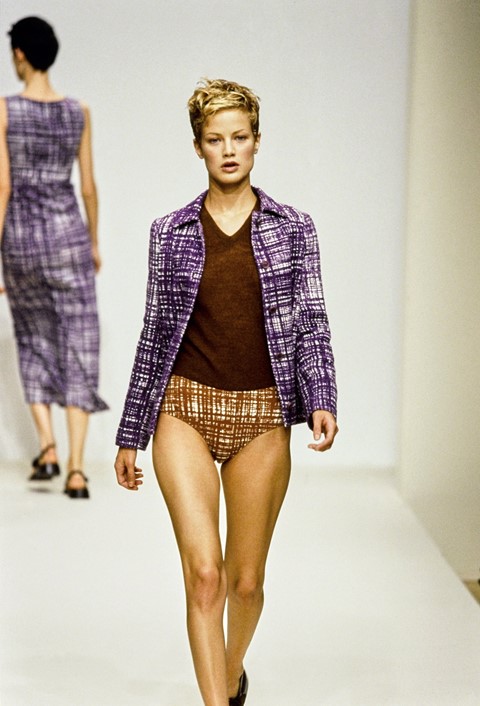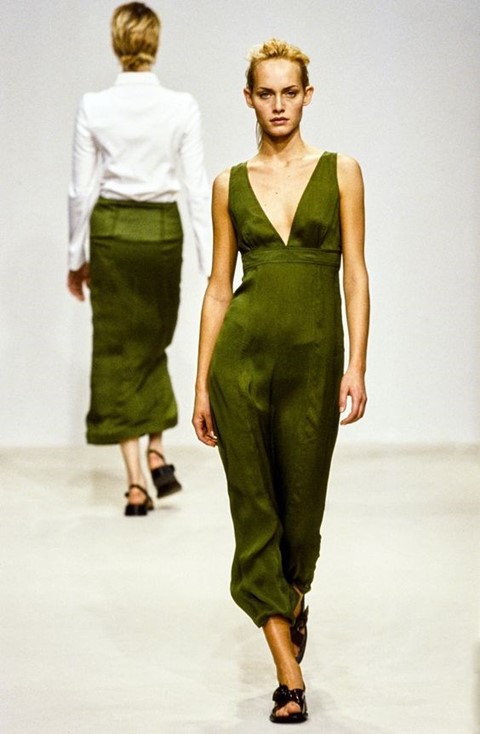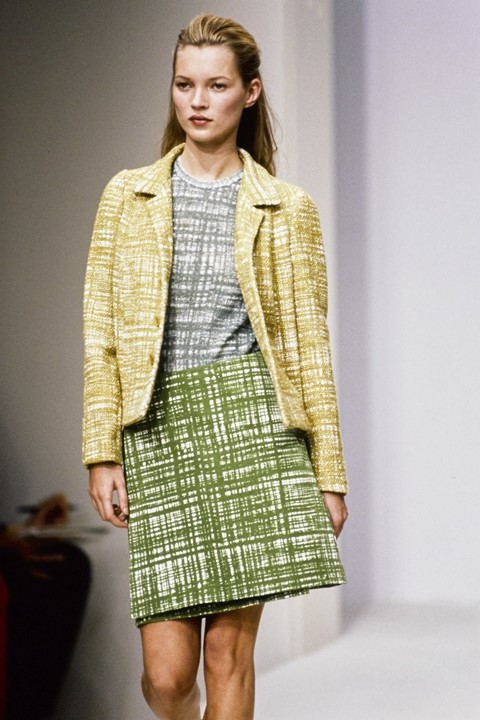Eschewing conventional ideals of beauty and sexuality, Prada's S/S96 collection first introduced us to off-key cool
“It is oft-quoted folklore that Miuccia Prada is the designer who made ‘ugly’ chic: the term belle laide could, at that point in her career, have been invented for her,” writes Susannah Frankel in the cover story for AnOther Magazine S/S17. This change has been defined as the moment that 70s-inspired avocado and ochre hues hit the Prada S/S96 runway to the ‘Rio Boogie’ beats of Marcos Valle. Veering away from her own gauzy and minimalist cleanliness and the sexiness that characterised Tom Ford’s Gucci of the same decade, Mrs Prada offered a collection titled Banal Eccentricity: a retro-inspired brand of geek chic which was reviled and adored in equal measure. Little did we know at the time how this new tune of off-kilter cool would continue to inform designers to this day.
Having taken the helm of her family business back in the late 70s, Mrs Prada created a discreetly coveted brand – beginning with the accessories, which were an evolution of her grandfather’s own principles (she turned the saffiano leather of his steamer trunks into handbags, and in the 1984, that nylon backpack). It wasn’t until the late 80s that Prada began creating womenswear. “At the start, there was Versace, there was Armani, and everything was much more loud than what Miuccia was doing,” Prada’s design director Fabio Zambernardi told Susannah Frankel. “No one paid much attention. The attention started to happen when the shows became a little more out there with ideas and concepts that seemed more shocking, shocking in the use of wrong materials, the use of nylon no longer just for bags, the exploration of ugliness versus beauty.”
The Show
“Ugly is in” – so was titled Pulitzer Prize-winning Robin D. Givhan’s article for The Washington Post back in May 1996. She was referring to “trend setter” Miuccia Prada, who had led the way with looks that were “stiff and unflattering” and greens “hovered somewhere between shades of slime and mold. The browns were murky – the color of water as it stagnates over a long, steamy summer”. This brown – as Susannah Frankel wrote – has “always upheld its virtues as ‘the least commercial of all the colours’” for Prada. When described as “faecal brown”, as AnOther contributor Alexander Fury once put it, we begin to understand why. Though the shade had appeared in clean cut suits earlier that decade, it had never before been married with shades of avocado, chartreuse, turquoise and lilac – let alone in the formica table graphics and librarian length skirts that emerged that season.
By all accounts, chunky T-bar sandals and sliders, both flat and unorthodoxly low-heeled, with oversized buttons and a trompe l’oeil tweed print defied the 90s sexy ideals. “Everything that mattered then was to be beautiful: your foot needed to look elegant, you wanted to be sexy,” Zambernardi continues. “That wasn’t of interest to Miuccia and therefore it wasn’t of interest to me. I wasn’t interested in giving her nice shoes.” As designers today look back towards the 90s, it’s exactly this shoe moment they’re talking to.

The People
Kristen McMenamy opened the show; fellow 90s heroines Amber Valetta, Kate Moss, Shalom Harlow, Kirsty Hume and Carolyn Murphy, followed. Murphy, with her yellow-bleach-blonde pixie crop, led that season’s campaign and, with her strikingly angular features so confidently exposed, seemed as if to embody the collection’s confrontational and unconventional standpoint. The S/S96 line-up was peak second generation supermodel: it was the moment of the waif. A change in the waters was nigh: as casting director James Scully recently pointed out, it was Prada who, in the late 90s, ushered in the era of the anonymous, uniform model. This trend – albeit an arguably negative one – Scully concedes has since been upturned by the brand as it continues to champion the new, young faces it introduces.
If anything could prove the allure of this new ugliness, it may be Madonna’s adoption of the collection. Typically bubbling with her own sexuality, wearing Jean-Paul Gaultier’s conical bras, or simply baring her breasts on the designer’s catwalk, Madonna wore a chartreuse trouser suit from the collection to the VH1 Fashion & Music Awards in 1995. It was in this boxy, buttoned-to-the-throat ensemble that, perhaps tellingly, the singer collected her award for Most Fashionable Artist – a block of Prada lilac eyeshadow smeared across her lids.

The Impact
Guests such as Tim Blanks have since referred to this show as “Prada’s turning-of-the-tide ‘pretty/ugly’ collection”. At the Met Museum’s 2012 exhibition, Schiaparelli and Prada: Impossible Conversations, (the dedicated exhibition being just another example of Mrs Prada’s enduring impact) journalist Charlie Porter recalled “how shocking this collection was when it first came out. [The S/S96 looks exhibited] were so radical.” And of Prada’s Ugly Chic collection, Alexander Fury more recently noted in an article for The Independent, that the collection “got us all to wear chocolate brown and gave vintage sales a boost. In retrospect, it caused a seismic sartorial shift in a similar manner to Christian Dior’s ‘New Look’ of 1947. Miuccia’s fugly frocks, the knowing naffness of her Bri-Nylon, crocheted tights and toilet-bowl heels, have influenced the way entire generations of designers create clothing.”
This was by no means the last time Mrs Prada would influence her peers. While designers Marc Jacobs, Jonathan Anderson and Edward Meadham all note Prada’s inspiration, the rest of the fashion industry reference her as if by osmosis. For S/S12, when Mrs Prada deemed 50s diner-wear en vogue, so too did every fashion glossy: cue a swathe of editorials teeming with pink milkshakes, jukeboxes and vintage cars. When Mrs Prada aped the humble velcro-strapped Teva sandal for S/S14, sales of the long-overlooked outdoorsy shoe spiked. Today, amid an obsession for all things 90s, this decade has seen a enduring love affair with that same chunky sandal that Prada introduced for 1996. As one of the largest fashion houses in the world, taking over £3bn in sales per year, with over 600 boutiques and 12,000 employees, Prada swings from strength to strength inspiring designers today, to the same huge extent as it did with this “tide-turning” show.
